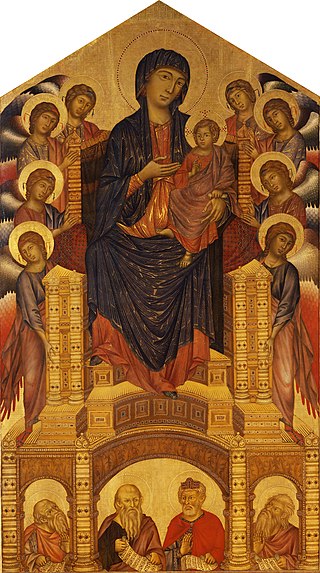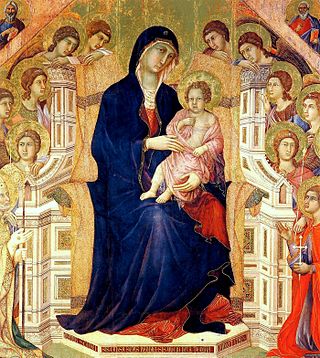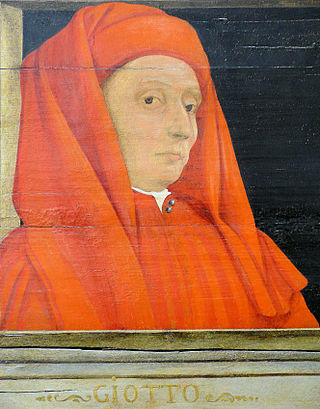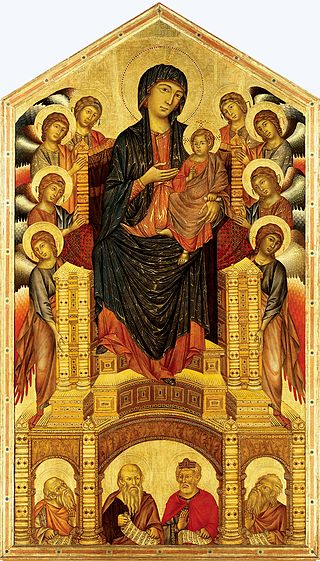Related Research Articles

Cimabue, c. 1240 – 1302, was an Italian painter and designer of mosaics from Florence. He was also known as Cenni di Pepo or Cenni di Pepi.

Duccio di Buoninsegna, commonly known as just Duccio, was an Italian painter active in Siena, Tuscany, in the late 13th and early 14th century. He was hired throughout his life to complete many important works in government and religious buildings around Italy. Duccio is considered one of the greatest Italian painters of the Middle Ages, and is credited with creating the painting styles of Trecento and the Sienese school. He also contributed significantly to the Sienese Gothic style.

Pietro Lorenzetti or Pietro Laurati was an Italian painter, active between c. 1306 and 1345. Together with his younger brother Ambrogio, he introduced naturalism into Sienese art. In their artistry and experiments with three-dimensional and spatial arrangements, the brothers foreshadowed the art of the Renaissance.

Maestà, the Italian word for "majesty", designates a classification of images of the enthroned Madonna with the child Jesus, the designation generally implying accompaniment by angels, saints, or both. The Maestà is an extension of the "Seat of Wisdom" theme of the seated "Mary Theotokos", "Mary Mother of God", which is a counterpart to the earlier icon of Christ in Majesty, the enthroned Christ that is familiar in Byzantine mosaics. Maria Regina is an art historians' synonym for the iconic image of Mary enthroned, with or without the Child.

Giunta Pisano was an Italian painter. He is the earliest Italian painter whose name is found inscribed on an extant work. He is best known for his crucifixes.

Pisa Cathedral is a medieval Roman Catholic cathedral dedicated to the Assumption of the Virgin Mary, in the Piazza dei Miracoli in Pisa, Italy, the oldest of the three structures in the plaza followed by the Pisa Baptistry and the Campanile known as the Leaning Tower of Pisa. The cathedral is a notable example of Romanesque architecture, in particular the style known as Pisan Romanesque. Consecrated in 1118, it is the seat of the Archbishop of Pisa. Construction began in 1063 and was completed in 1092. Additional enlargements and a new facade were built in the 12th century and the roof was replaced after damage from a fire in 1595.

Santa Trinita is a Roman Catholic church located in front of the piazza of the same name, traversed by Via de' Tornabuoni, in central Florence, Tuscany, Italy. It is the mother church of the Vallumbrosan Order of Monks, founded in 1092 by a Florentine nobleman. South on Via de' Tornabuoni is the Ponte Santa Trinita over the river Arno; across the street is the Palazzo Spini Feroni.

Lippo Memmi was an Italian painter from Siena. He was the foremost follower of Simone Martini, who was his brother-in-law.

Santa Maria dei Servi is a Roman Catholic basilica in Bologna, Italy.
The decade of the 1280s in art involved some significant events.

Giotto di Bondone, known mononymously as Giotto and Latinised as Giottus, was an Italian painter and architect from Florence during the Late Middle Ages. He worked during the Gothic and Proto-Renaissance period. Giotto's contemporary, the banker and chronicler Giovanni Villani, wrote that Giotto was "the most sovereign master of painting in his time, who drew all his figures and their postures according to nature" and of his publicly recognized "talent and excellence". Giorgio Vasari described Giotto as making a decisive break from the prevalent Byzantine style and as initiating "the great art of painting as we know it today, introducing the technique of drawing accurately from life, which had been neglected for more than two hundred years".

Saint Francis Receiving the Stigmata is a panel painting in tempera by the Italian artist Giotto, painted around 1295–1300 for the Church of Saint Francis in Pisa and it is now in the Musée du Louvre in Paris. It shows an episode from the life of Saint Francis of Assisi, and is 314 cm high by 162 cm wide. It is signed OPUS IOCTI FLORENTINI.

The Maestà is a painting by the Italian artist Cimabue, executed around 1280 and housed in the Musée du Louvre in Paris.

The Santa Trinita Maestà is a panel painting by the Italian medieval artist Cimabue, dating to c. 1288-1292. Originally painted for the church of Santa Trinita, Florence, where it remained until 1471, it is now housed in the Uffizi Gallery of Florence, Italy. It represents the Madonna enthroned with the Baby Jesus and surrounded by eight angels and, below, four half portraits of prophets.

The Crucifix by Cimabue at Santa Croce is a very large wooden crucifix, painted in distemper, attributed to the Florentine painter and mosaicist Cimabue, one of two large crucifixes attributed to him. The work was commissioned by the Franciscan friars of Santa Croce and is built from a complex arrangement of five main and eight ancillary timber boards. It is one of the first Italian artworks to break from the late medieval Byzantine style and is renowned for its technical innovations and humanistic iconography.

The Crucifix by Cimabue at Arezzo is a large wooden crucifix painted in distemper, with gold leaf, by the Florentine painter and mosaicist Cimabue, dated to c. 1267–71. It is the earliest of two large crucifixes attributed to him. It shows a painted representation of the near dead body of Christ on the cross, with Mary, mother of Jesus and John the Evangelist at either end of the cross beams.

The Flagellation of Christ is a panel painting by the Italian artist Cimabue, in egg tempera and gold leaf on a poplar panel, dated to c. 1280. It has been held by the Frick Collection in New York since 1950, and is the only painting by Cimabue in the United States. The Frick Collection acquired the painting from the Knoedler gallery in Paris in 1950. Previously, it had been owned by the antiques dealer M. Rolla at the end of the 19th century, inherited by G. Rolla, and then sold to the art dealer Eduardo Moratilla.

The Maestà of Santa Maria dei Servi is a tempera and gold on panel painting by Cimabue or his workshop, dating to c.1280-1285, between his Louvre Maestà (c.1280) on the one hand and the Assisi frescoes (1288-1292) and the Santa Trinita Maestà (c.1290-1300) on the other. It is named after the church of Santa Maria dei Servi in Bologna, where it hangs.